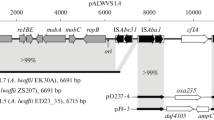Abstract
Resistance to the industrial biocide hexahydro-1,3,5-triethyl-s-triazine (HHTT) by a strain ofPseudomonas putida was shown to be encoded by a 32.5-megadalton (Mdal) plasmid as evidenced: (a) by visualization of the plasmid DNA by agarose gel electrophoresis, (b) by the loss of HHTT resistance as well as the loss of the 32.5-Mdal plasmid upon curing with novobiocin, and (c) by conjugal concomitant transfer of HHTT resistance and the 32.5-Mdal plasmid by mating the novobiocin-cured HHTT-sensitive derivative with the HHTT-resistant strain. The 32.5 Mdal did not encode for heavy metal or antibiotic resistance, and it was shown not to be one of the “degradative” plasmids ofPseudomonas. The mechanism of HHTT resistance was not discerned from these studies.
Similar content being viewed by others
Literature Cited
Ahonkhai I, Russell AD (1979) Response of RP1+ and RP1− strains ofEscherichia coli to antibacterial agents and transfer of resistance toPseudomonas aeruginosa. Curr Microbiol 3:89–94
Anderson TG (1970) Testing of susceptibility of antimicrobial agents in body fluids. In: Blair JE, Lennette EH, Truant JP (eds) Manual of clinical microbiology. Bethesda MD: American Society for Microbiology, pp 299–310
Block SS (1977) Preservatives for industrial products. In: Block SS (ed) Disinfection, sterilization, and preservation, 2nd edn. Philadelphia: Lea and Febiger, pp 788–833
Candal FJ, Eagon RG (1985) Evidence for plasmid-mediated bacterial resistance to industrial biocides. Int Biodeterioration 20: 221–224
Chakrabarty AM (1976) Plasmids ofPseudomonas. Annu Rev Genet 10:7–30
Datta N, Hedges RW, Shaw EJ, Sykes RB, Richmond MH (1971) Properties of an R factor fromPseudomonas aeruginosa. J Bacteriol 108:1244–1249
Eagon RG, Phibbs PV Jr (1971) Kinetics of transport of glucose, fructose, and mannitol byPseudomonas aeruginosa. Can J Biochem 49:1031–1041
Foster RJ (1983) Plasmid-determined resistance to antimicrobial drugs and toxic metal ions in bacteria. Microbiol Rev 47:361–409
Holloway BW, Richmond MH (1973) R-Factors used for genetic studies in strains ofPseudomonas aeruginosa and their origin. Genet Res 21:103–105
Izzat IN, Bennett EO (1979) The potentiation of cutting fluid preservatives by diethylene triamine pentaacetic acid. Int Biodeterioration Bull 15:1–6
Kado CI, Liu S-T (1981) Rapid procedure for detection and isolation of large and small plasmids. J Bacteriol 145:1365–1373
Lutey RW, May OW (1978) Preservatives. In: Landers BG, Knoll L (eds) Paper coating additives. New York: TAPPI Press, pp 106–125
Onyekwelu IU, Bennett EO (1979) The effects of filtering agents upon the activity of preservatives in cutting fluids. Int Biodeterioration Bull 15:88–95
Rossmore HW (1979) Heterocyclic compounds as industrial biocides. Dev Indust Microbiol 20:41–71
Sharpell F (1980) Industrial uses of biocides in processes and products. Dev Indust Microbiol 21:133–140
Silver S, Budd K, Leahy KM, Shaw WV, Hammond D, Novick RP, Willsky GR, Malamy MH, Rosenberg H (1981) Inducible plasmid-determined resistance to arsenate, arsenite, and antimony(III) inEscherichia coli andStaphylococcus aureus. J Bacteriol 146:983–996
Stotzky G, Rem LT (1966) Influence of clay minerals on microorganisms. Can J Microbiol 12:547–563
Summers AO, Lewis E (1972) Volatilization of mercuric chloride by mercury resistant plasmid-bearing strains ofEscherichia coli, Staphylococcus aureus, andPseudomonas aeruginosa. J Bacteriol 113:1070–1072
Sykes RB, Richmond MH (1970) Intergeneric transfer of a β-lactamase gene betweenPs. aeruginosa andE. coli. Nature 226:952–954
Author information
Authors and Affiliations
Rights and permissions
About this article
Cite this article
Hall, E., Eagon, R.G. Evidence for plasmid-mediated resistance ofPseudomonas putida to hexahydro-1,3,5-triethyl-s-triazine. Current Microbiology 12, 17–22 (1985). https://doi.org/10.1007/BF01567747
Issue Date:
DOI: https://doi.org/10.1007/BF01567747




